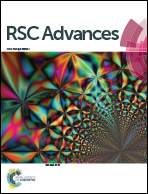Peptidomimetic organocatalysts: efficient Michael addition of ketones onto nitroolefins with very low catalyst loading†
Abstract
The syntheses of two novel peptidomimetic triazole-based organocatalysts that work for the asymmetric conjugate addition of cyclohexanone to nitroolefins are described. The catalysts worked with very low loading (0.5 mol%) in the absence of any additives to provide high diastereo- and enantio-selectivities.


 Please wait while we load your content...
Please wait while we load your content...